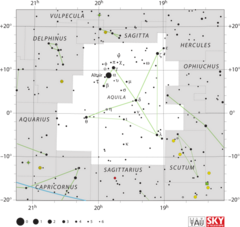Astronomy:Phi Aquilae
| Observation data Equinox J2000.0]] (ICRS) | |
|---|---|
| Constellation | Aquila |
| Right ascension | 19h 56m 14.25183s[1] |
| Declination | +11° 25′ 25.3931″[1] |
| Apparent magnitude (V) | +5.28[2] |
| Characteristics | |
| Spectral type | A1 IV[3] |
| U−B color index | –0.02[2] |
| B−V color index | +0.00[2] |
| Astrometry | |
| Radial velocity (Rv) | –27.2[4] km/s |
| Proper motion (μ) | RA: +32.826[1] mas/yr Dec.: +6.162[1] mas/yr |
| Parallax (π) | 14.1980 ± 0.1579 mas |
| Distance | 230 ± 3 ly (70.4 ± 0.8 pc) |
| Absolute magnitude (MV) | +1.14[5] |
| Orbit[6] | |
| Period (P) | 3.32068 days |
| Eccentricity (e) | 0.025 |
| Periastron epoch (T) | JD 2423210.628 |
| Argument of periastron (ω) (secondary) | 43° |
| Semi-amplitude (K1) (primary) | 37.2 km/s |
| Details | |
| A | |
| Mass | 2.39[7] M☉ |
| Radius | 1.8–2.5[8] R☉ |
| Luminosity | 34[5] L☉ |
| Surface gravity (log g) | 4.30[9] cgs |
| Temperature | 9,509[9] K |
| Metallicity [Fe/H] | +0.47[9] dex |
| Rotational velocity (v sin i) | 27[10] km/s |
| Age | 280[7] Myr |
| B | |
| Mass | 0.40[7] M☉ |
| Other designations | |
| Database references | |
| SIMBAD | data |
Phi Aquilae, Latinized from φ Aquilae, is the Bayer designation of a binary star[12] system in the equatorial constellation of Aquila. It has an apparent visual magnitude of +5.28[2] and is visible to the naked eye. With an annual parallax shift of 14.198 mas,[1] this star is located at a distance of approximately 230 light-years (71 parsecs) from Earth. It is drifting closer with a radial velocity of –27 km/s.[4] Based on its motion through space, this system is considered a possible member of the nearby Argus association of co-moving stars, although it may be too old.[13]
Phi Aquilae is a single-lined spectroscopic binary with an orbital period of 3.32068 days.[6] The pair have a projected separation of 190.4 astronomical unit|AU as of 2008.[7] The primary component is a subgiant star with a stellar classification of A1 IV.[3] The star is around 280[7] million years old and is spinning with a projected rotational velocity of 27.[10] It has 2.39[7] times the mass of the Sun and somewhere in the range of 1.8–2.5[8] times the Sun's radius. The outer atmosphere has an effective temperature of 9,509 K,[9] giving it the white-hued appearance of an A-type star.[14] It is radiating 34[5] times the luminosity of the Sun.
The orbiting companion may be the source of the X-ray emission from this system, as stars similar to the primary component do not generally produce detectable levels of X-rays.[15] It has 40% of the mass of the Sun.[7]
References
- ↑ 1.0 1.1 1.2 1.3 1.4 Brown, A. G. A. (August 2018). "Gaia Data Release 2: Summary of the contents and survey properties". Astronomy & Astrophysics 616: A1. doi:10.1051/0004-6361/201833051. Bibcode: 2018A&A...616A...1G. Gaia DR2 record for this source at VizieR.
- ↑ 2.0 2.1 2.2 2.3 Oja, T. (April 1983), "UBV photometry of FK4 and FK4 supplement stars", Astronomy and Astrophysics Supplement Series 52: 131–134, Bibcode: 1983A&AS...52..131O.
- ↑ 3.0 3.1 Cowley, A. et al. (April 1969), "A study of the bright A stars. I. A catalogue of spectral classifications", Astronomical Journal 74: 375–406, doi:10.1086/110819, Bibcode: 1969AJ.....74..375C.
- ↑ 4.0 4.1 Wilson, Ralph Elmer (1953), "General catalogue of stellar radial velocities", Carnegie Institute Washington D.C. Publication (Carnegie Institution of Washington), Bibcode: 1953GCRV..C......0W.
- ↑ 5.0 5.1 5.2 Anderson, E.; Francis, Ch. (2012), "XHIP: An extended hipparcos compilation", Astronomy Letters 38 (5): 331, doi:10.1134/S1063773712050015, Bibcode: 2012AstL...38..331A.
- ↑ 6.0 6.1 Lucy, L. B.; Sweeney, M. A. (August 1971), "Spectroscopic binaries with circular orbits", Astronomical Journal 76: 544–556, doi:10.1086/111159, Bibcode: 1971AJ.....76..544L.
- ↑ 7.0 7.1 7.2 7.3 7.4 7.5 7.6 De Rosa, R. J.; Patience, J.; Wilson, P. A.; Schneider, A.; Wiktorowicz, S. J.; Vigan, A.; Marois, C.; Song, I. et al. (2014), "The VAST Survey - III. The multiplicity of A-type stars within 75 pc", Monthly Notices of the Royal Astronomical Society 437 (2): 1216–1240, doi:10.1093/mnras/stt1932, Bibcode: 2014MNRAS.437.1216D.
- ↑ 8.0 8.1 Pasinetti Fracassini, L. E. et al. (February 2001), "Catalogue of Apparent Diameters and Absolute Radii of Stars (CADARS) - Third edition - Comments and statistics", Astronomy and Astrophysics 367 (2): 521–524, doi:10.1051/0004-6361:20000451, Bibcode: 2001A&A...367..521P.
- ↑ 9.0 9.1 9.2 9.3 Soubiran, C.; Le Campion, J.-F.; Cayrel de Strobel, G.; Caillo, A. (June 2010), "The PASTEL catalogue of stellar parameters", Astronomy and Astrophysics 515: A111, doi:10.1051/0004-6361/201014247, Bibcode: 2010A&A...515A.111S.
- ↑ 10.0 10.1 Royer, F.; Zorec, J.; Gómez, A. E. (February 2007), "Rotational velocities of A-type stars. III. Velocity distributions", Astronomy and Astrophysics 463 (2): 671–682, doi:10.1051/0004-6361:20065224, Bibcode: 2007A&A...463..671R.
- ↑ "phi Aql -- Star", SIMBAD (Centre de Données astronomiques de Strasbourg), http://simbad.u-strasbg.fr/simbad/sim-id?Ident=Phi+Aquilae, retrieved 2012-07-21.
- ↑ Eggleton, P. P.; Tokovinin, A. A. (September 2008), "A catalogue of multiplicity among bright stellar systems", Monthly Notices of the Royal Astronomical Society 389 (2): 869–879, doi:10.1111/j.1365-2966.2008.13596.x, Bibcode: 2008MNRAS.389..869E.
- ↑ Zuckerman, B. (January 2019), "The Nearby, Young, Argus Association: Membership, Age, and Dusty Debris Disks", The Astrophysical Journal 870 (1): 8, doi:10.3847/1538-4357/aaee66, 27, Bibcode: 2019ApJ...870...27Z.
- ↑ "The Colour of Stars", Australia Telescope, Outreach and Education (Commonwealth Scientific and Industrial Research Organisation), December 21, 2004, http://outreach.atnf.csiro.au/education/senior/astrophysics/photometry_colour.html, retrieved 2012-01-16
- ↑ De Rosa, R. J. et al. (July 2011), "The Volume-limited A-Star (VAST) survey - I. Companions and the unexpected X-ray detection of B6-A7 stars", Monthly Notices of the Royal Astronomical Society 415 (1): 854–866, doi:10.1111/j.1365-2966.2011.18765.x, Bibcode: 2011MNRAS.415..854D.
External links
 |


